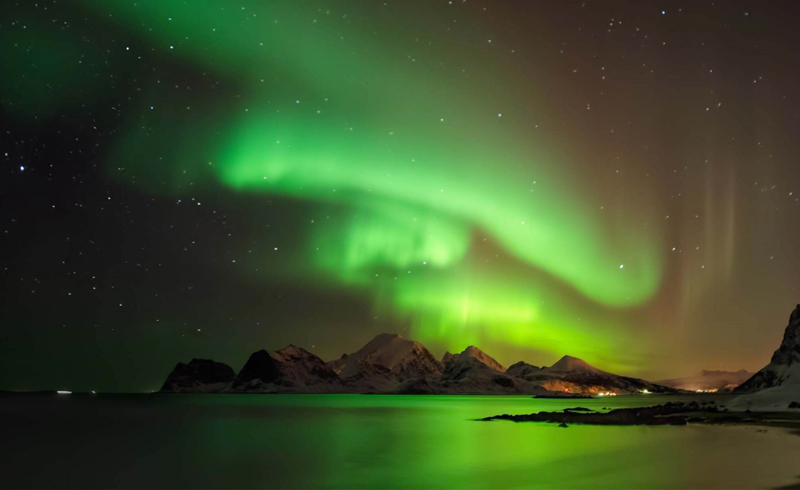After the spring equinox, the days will get longer, with earlier dawns and later sunsets.

By
Jamie Carter, Travel + Leisure
Are you ready for spring? Astronomically-speaking, it begins on March 19. For many of us, the spring equinox—also called the March or vernal equinox—is merely a date on the calendar of little real-life significance. However, equinoxes and solstices are natural waymarkers in the year, and they remind us of the changing seasons, the wax and wane of the days, and of our own place in space.
So what is the spring equinox, and what's it got to do with the northern lights?
Are you ready for spring? Astronomically-speaking, it begins on March 19. For many of us, the spring equinox—also called the March or vernal equinox—is merely a date on the calendar of little real-life significance. However, equinoxes and solstices are natural waymarkers in the year, and they remind us of the changing seasons, the wax and wane of the days, and of our own place in space.
So what is the spring equinox, and what's it got to do with the northern lights?
When is the 2020 spring equinox?
A global event marking the time the sun hangs directly over Earth's equator at midday, the spring equinox will occur in the Northern Hemisphere at 03:50 Universal Time on Friday, March 20. That's 11:50 p.m. E.T., so technically it occurs on Thursday, March 19 in North America. That's the earliest the equinox has occurred in the U.S. for 124 years.What is the spring equinox?
"Equinox" means "equal night," so during the spring equinox, there are equal hours of daylight and darkness. It's when the sun appears directly over Earth's equator, which happens because Earth's axis is facing the sun. The axis on which Earth rotates is tilted by 23.5°, so during its annual orbit around the sun, different parts of Earth receive sunlight for different lengths of time. The spring equinox in March marks the point when the Southern Hemisphere begins to tilt away from the sun and the Northern Hemisphere begins to tilt towards the sun. Consequently, the sun appears to leave the Southern Hemisphere and cross the celestial equator (the Earth's equator projected into the sky) and move into the Northern Hemisphere. The result is longer, warmer days in the Northern Hemisphere. There are two equinoxes each year, each one halfway between the solstices.Why are the northern lights strongest around the spring equinox?
The northern lights are caused by charged particles from the sun (called the "solar wind") hitting the Earth's magnetosphere, the area of space where the magnetic field of Earth dominates. Around the equinoxes, the Earth's axis is side-on to the sun, which happens to sync with the magnetic field of the solar wind. That means that during the equinoxes, charged particles are more likely to be accelerated down the field lines of Earth's magnetosphere.Visit the Arctic Circle on or close to the equinox, and you will have a higher chance of seeing a northern lights display.
Though there are no guarantees, this year, the days close to the spring equinox are a particularly good time to go hunting for the northern lights because there will be dark, moonless night skies.
Where will the northern lights be visible this spring?
After the spring equinox, the nights will quickly get shorter, minimizing your time to see the northern lights. However, the next few weeks are ideal for seeing heightened displays, and if you're willing to stay up very late, they can be seen for some time yet. The northern lights occur in an "auroral oval" around the North Pole, so the Arctic Circle is the place to be to see frequent displays. The best places for North Americans to see the northern lights are Fairbanks, Alaska and Yellowknife in northern Canada. For Europeans, the best places are Iceland, Finnish Lapland, Swedish Lapland, and northern Norway. Greenland and northern Russia also see the northern lights, but they're a bit more remote.When is the summer solstice in 2020?
The Northern Hemisphere's longest day of the year will occur on Saturday, June 20, 2020. On that date at midday, the sun will hang its highest in the sky during 2020, crossing the Tropic of Cancer. That happens because at the summer solstice, the Northern Hemisphere is tilted towards the sun. The Northern Hemisphere gets the full glare of the sun's rays, which means the longest day and the warmest temperatures. Astronomically speaking, it's the beginning of summer, and at the North Pole, the sun will not set.The spring equinox is not something you can easily observe, but it's nevertheless an important date in our planet's annual journey through space.
See more at: Travel + Leisure
![[feature] The Northern Lights Could Be Extra Bright During the Spring Equinox This Week](https://blogger.googleusercontent.com/img/b/R29vZ2xl/AVvXsEiZTjdi6UgKtiKGKLXWQ7Dq5hUB5WKdjnLxlnTkfS_9RZoFcPV5n8X4hrS0xYfymd7YQp324pWQRjOvHlNnWK83F09USn5Nk36tNU_bWmZmwobGxwasX4HuWYT6M8k-Xm5YtaBMADirGvk/s1600-rw/women+5.jpg)

























